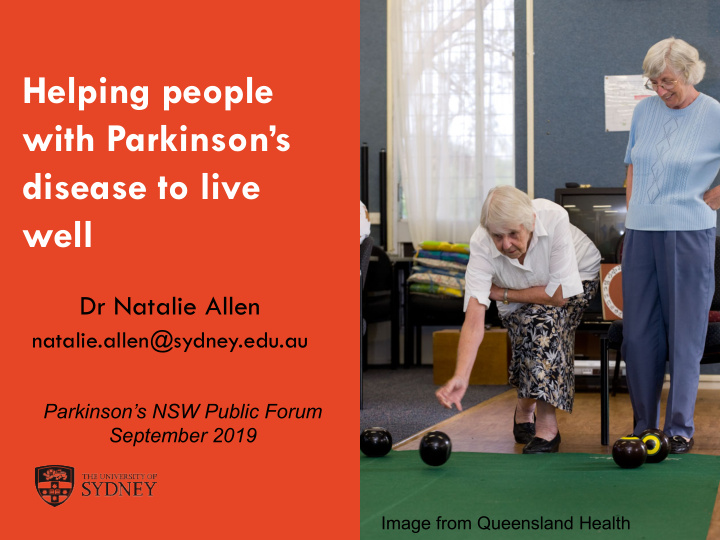



Helping people with Parkinson’s disease to live well Dr Natalie Allen natalie.allen@sydney.edu.au Parkinson’s NSW Public Forum September 2019 The University of Sydney Page 1 Image from Queensland Health
Background – As PD progresses, people develop a variety of motor and non-motor problems, including – trouble walking – falls – pain – Overall research aim: Image from Queensland Health To help people with PD and their families live better by maintaining safe mobility and managing pain The University of Sydney Page 2
Background - pain – People with more pain undertook less exercise (Allen et al, 2015, Movement Disorders Clinical Practice) – Systematic review – carefully prescribed exercise might be effective in reducing pain through neurochemical and neuroplastic changes (Allen et al, Image from: http://painpatient.com/2014/07/30/relieving-elderly- aches-pains/ 2015, Journal of Parkinson’s Disease) – In some chronic pain conditions (eg fibromyalgia), exercise can increase pain sensitivity The University of Sydney Page 3
Grant PNSW Grant 2016: Towards effective exercise prescription to reduce pain in people with Parkinson’ s disease AIMS: 1. To determine if exercise had an immediate reduction in pain sensitivity (exercise-induced hypoalgesia) 2. To explore relationships between pain, physical activity, sleep and mood The University of Sydney Page 4
Publication The University of Sydney Page 5
Exercise sensitivity and pain in people with Parkinson’s disease. Measurement of pressure pain thresholds before and after: - 3 minutes of arm exercise (isometric elbow flexor contraction at 40% 1RM) - Treadmill walking at light intensity - Treadmill walking at moderate intensity The University of Sydney Page 6
Exercise leads to an immediate reduction in pain sensitivity in most people Overall increase in pressure-pain threshold following both isometric arm exercise and aerobic treadmill walking (showing exercise induced hypoalgesia) In people with PD No difference between people with and without PD In people without PD BUT Some individuals did not have this response The University of Sydney Page 7
Increased physical activity, poor sleep and low mood were associated with increased pain Increased physical activity Sleep disturbance Increased pain Anxiety and depression These variables accounted for up to 56% of the variance in the pain scale measure The University of Sydney Page 8
association ≠ causation - Increased activity to manage pain? - Inappropriate activity? The University of Sydney Page 9
Exercise for pain management Most people with PD have the usual immediate analgesic response to exercise. The analgesic response occurs after both aerobic and resistance exercise. People with PD and pain should consult a physiotherapist to assist them https://www.painmanagementdenverco.com/pain-management.html to establish, monitor and progress an appropriate exercise program The University of Sydney Page 10
Background – safe mobility – Exercise reduces fall rates in people with mild to moderate PD (Canning et al, 2015, Neurology) – Despite this, the rate of falls remains unacceptably high – Exercise alone does not reduce falls in people with more severe disease. – Cognitive problems are associated with increased falls, but most studies exclude people with cognitive problems. One size does not fit all! The University of Sydney Page 11
Grant PNSW Grant 2018: Integrate: a tailored and multifactorial program for safe mobility in people with more advanced Parkinson’s disease AIMS: Does the 6 month Integrate program improve: 1. Mobility and safe mobility behaviours and 2. Walking, freezing, leg muscle strength, concern about falling, activities of daily living, fatigue and care-partner burden in people with Parkinson’s disease? The University of Sydney Page 12
Pilot study 4 month trial (7 people and their care-partners) People found the program helpful and liked that it was: - Home based - Combined OT and physiotherapy, tailored for the individual - Therapists who are experts in Parkinson’s disease The University of Sydney Page 13
Integrate study 40 volunteers with Parkinson’s disease Keep a falls diary for 2 months Initial assessment (at home) RANDOM ALLOCATION Usual care group Integrate group - Usual activities and - OT and physiotherapy 6 months treatment home visits (8 to 12) - Keep a falls diary - Home modifications - Safe mobility strategies - Exercise 3 to 5 times per week - Keep a falls diary Final assessment (at home) Keep a falls diary for 6 months The University of Sydney Page 14
Integrate group – home-based OT and Physio for 6 months The University of Sydney Page 15
Who can participate? Diagnosis of idiopathic Parkinson’s disease Able to walk 10m on your own (walking aids are permitted) Have fallen at least 2 times in the last 6 months People with significant thinking problems will need a care-partner to participate with them Sydney greater-metropolitan area The University of Sydney Page 16
Acknowledgments – Participants – Collaborators – Ben Barry, Matt Brodie, Colleen Canning, Lindy Clemson, Jacqueline Close, Leanne Hassett, Simon Lewis, Niklas Lofgren, Stephen Lord, Niamh Moloney, Vanessa Nguy, Serene Paul, Cathie Sherrington, therapy staff – Parkinson’s NSW funding The University of Sydney Page 17
Recommend
More recommend